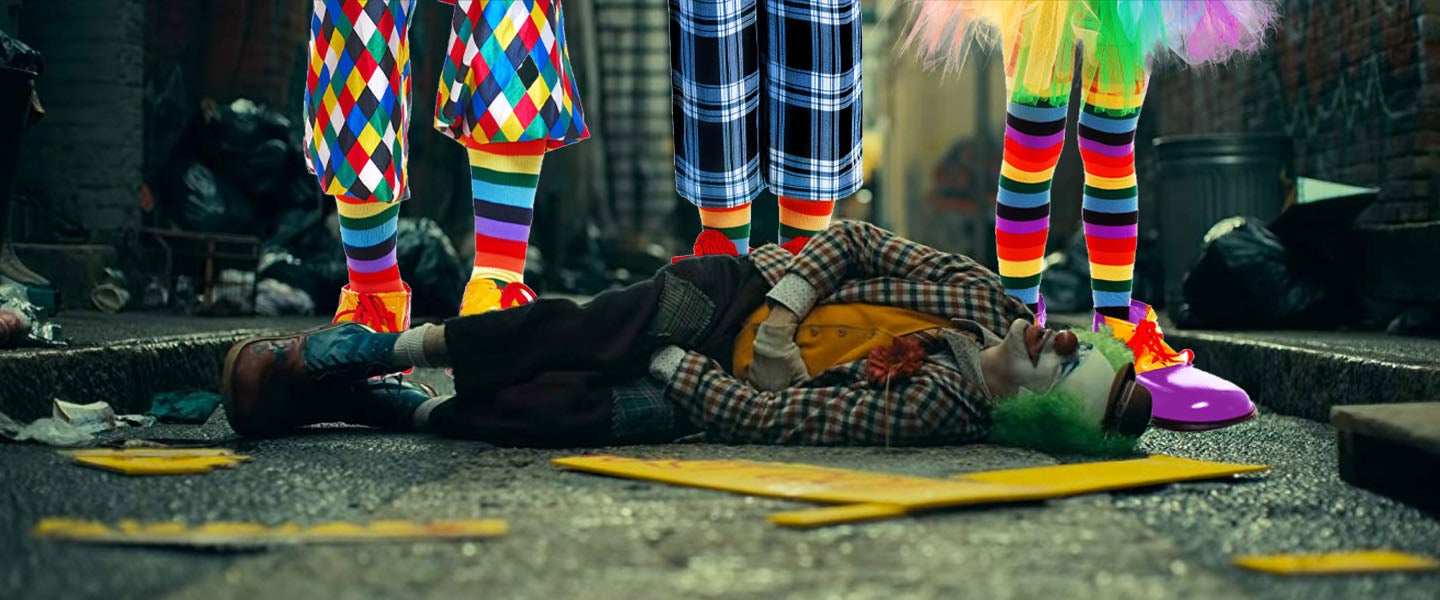I’m among the many people suspicious of Joker. But unlike most, my concern isn’t focused upon the violence, or the toxic masculinity, though both are potentially worthy targets — instead, my guts are in absolute knots over what this film will mean to the clown community.
Maybe the connection between the Joker and clowning are obvious, but by focusing on his origin story, Joker places his identity as a clown as the crux of his being, so much so that “clown” is identified as a demographic category — one which protestors in the street defend with the phrase, “We Are All Clowns.”
Joker asserts that clowns aren’t just scary, they’re political. But how does this fit within our larger cultural understanding of the role of the clown?
Getting answers proved surprisingly difficult at first. “It’s a superhero/fantasy movie with no basis in reality so it isn’t relevant to the art of clowning,” Bruce “Charlie” Johnson, a clown and clown historian, wrote via email when declining my request for comment. A Juggalo group on Facebook similarly declined, calling the request itself “r*tarded.”
Fortunately, not all clowns see Joker as completely disconnected to their career. “It’s almost a human condition that we need someone to be the underdog, to wrestle with these foibles. There’s something entrenched in being a human that makes us want someone to do this for us,” says Gilly, a professional clown in L.A. “I see the role of the clown to make people laugh, or to make people cry.”
Gilly hasn’t yet seen Joker, but he views it as a continuation of the recent “scary clown” trend that began with the 2017 version of It. Whether it be Pennywise or the Joker, Gilly sees these figures as reviving the country’s clown dialogue, for better or for worse. “There’s a lot of different clowns. Somewhere along the line, you have scary clowns. If that’s the one clown people want, at least it keeps clowns in the open; it keeps clowns alive. I don’t think that’s the best brand ambassador for all clowns, but at least it keeps them relevant.”
UPDATE: Professional Clowns Are All Kinds of Pissed About the ‘IT’ Remake
“Clowns have always been the canary in the coal mine for what people’s anxieties and feelings are,” Gilly continues. “In the 1930s, we had the Tramp Clown, because America was going through a Depression. That’s what they saw — they put a personal face on people that could have been their dads, their grandfathers, their uncles.” Tramp Clowns, like Emmett Kelly’s “Weary Willie,” dressed in ragged clothes and painted frowns upon their face to play the role of the homeless, itinerant workers of the Depression-era. He was “down on his luck,” worse off than his viewers, who were facing economic anxieties of their own.
“Clowns in the 1950s and 1960s were more cheery, and we had Ronald McDonald in the 1980s or 1990s saying, ‘Everything’s okay,’ like true consumerism, ‘just eat and you’ll be fine,’” says Gilly. “Now, since 2017, we’ve had scary clowns, and it’s not too crazy to think where that’s coming from. Look at the unrest we’ve had politically; it’s not crazy to me [that we have scary clowns].”
Perhaps because of this political unrest, uniting under a shared fear of clowns is a logical turn. “People know where they stand with clowns immediately,” Gilly reasons. “There’s a couple of things that Americans are pretty decided about –– one is kneeling for the flag, and one is clowns. They know exactly what they think. Ultimately, people crave community. It’s easier in this society right now to bond over things we hate than things we like. It’s convenient.”
Clowns have existed in nearly every culture, whether that be as the iconic red-nosed version, white-faced mimes or the archetype of the fool or prankster. Typically, clowns have held a liminal status in society –– neither elite, nor an ordinary citizen. As such, the clown or jester could play and joke in ways others could not. “As an actor, if you’re performing on stage, you need the audience, but you’re not going to interact with them,” says Gilly. “As a clown, you need people to interact with. You’re automatically trying to engage people, so I understand why people are threatened by it.”
But it’s still disappointing to Gilly when children ask him things like, “Are all clowns scary?” To him, the majority of clowns aren’t scary — we just hear more about the ones who are. Gilly himself works as a clown at hospitals, cheering up patients. “There are really wonderful stories being told, but they’re not the ones you see. You see the more salacious stories being told.”
Nevertheless, Gilly’s business hasn’t suffered as a result of scary clown discourse. “This year as a clown, I’ve done more work than I have in previous years — two or three years after these negative portrayals of clowns. I don’t know if there’s a correlation, but I’m doing three parties this weekend.”

